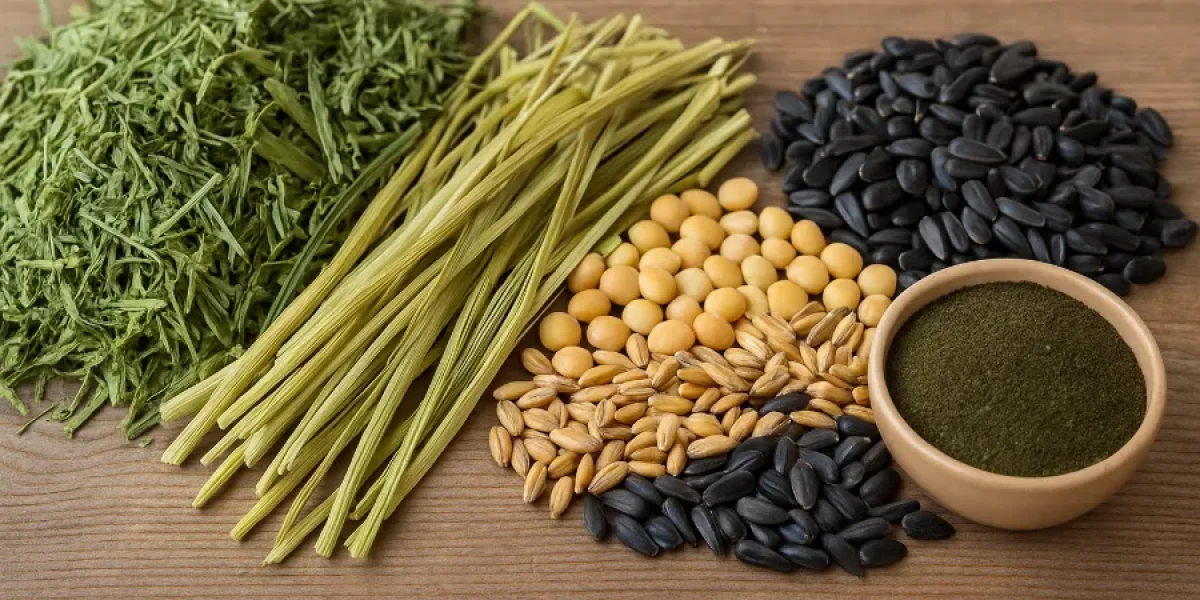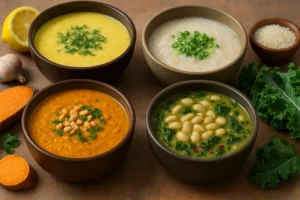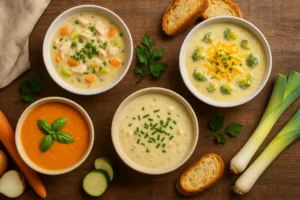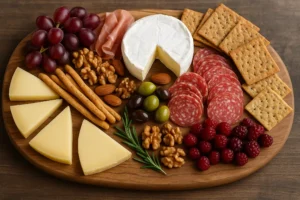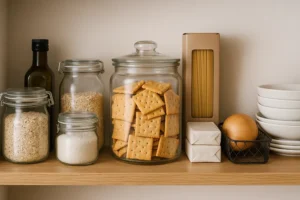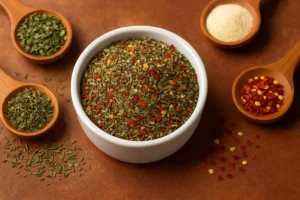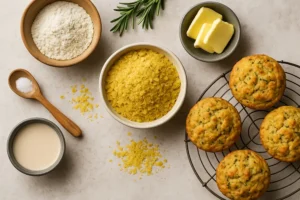When I first started feeding dairy goats, I thought any good hay and a scoop of grain would do. I quickly learned that feeding isn’t just about keeping goats full — it’s about giving their bodies the exact fuel they need to make milk, stay healthy, and thrive.
Over the years, I’ve built and refined my feeding system through hands-on experience, trial and error, and careful observation of how my does respond. Every season, I tweak the mix a little, learning more about how nutrition affects goat milk production, health, and the land itself.
In this post, I’ll walk you through everything I’ve learned — from goat feed choices to alfalfa hay, goat vitamins, and even regenerative grazing. Think of it as a full-circle look at how to feed your goats right, the natural way.
Goat Feed: What I Use and Why
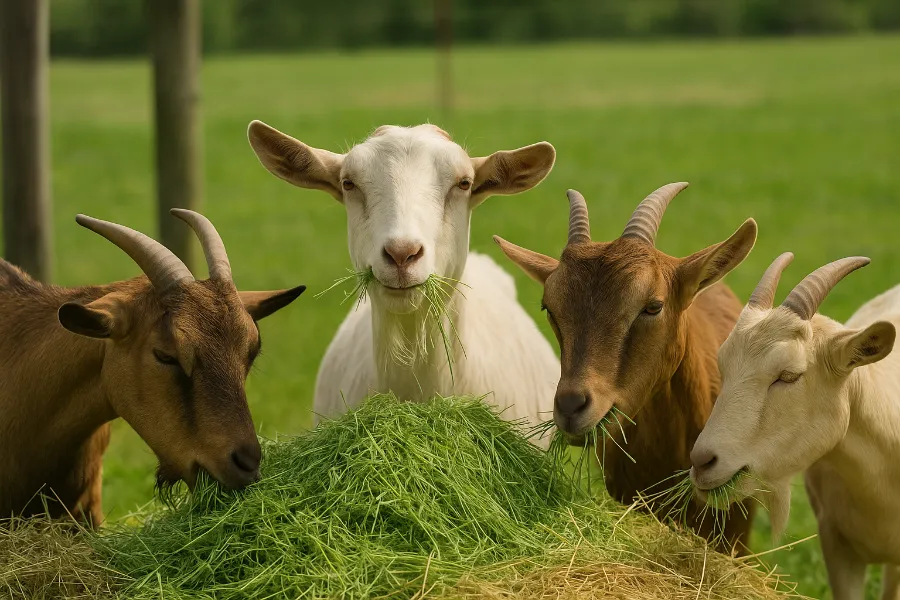
Good goat feed is the foundation of every successful dairy operation — big or small. My approach is simple: feed the rumen first, the goat second.
That means focusing on balance — a mix of roughage, energy, protein, and minerals that keeps their digestive system humming and milk flowing.
My feed breakdown looks something like this:
- 60–70% roughage (hay or browse)
- 20–30% concentrated feed (grains, legumes)
- The rest in minerals, vitamins, and supplements
Goats need consistency. I don’t change feeds suddenly — transitions happen over several days to protect their gut health. When their rumen is happy, milk yield stays steady, coats shine, and appetites stay strong.
Goat Feeding: My Daily Routine and Practical Tips
When it comes to goat feeding, routine is everything. Goats love structure — they’ll even remind you if you’re running late.
Here’s what my daily feeding schedule looks like:
| Time | Feed | Purpose |
|---|---|---|
| 6–7 AM | Grain mix + alfalfa hay | Energy and protein before morning milking |
| Midday | Pasture browse or grass hay | Keeps rumen active and content |
| 5–6 PM | Alfalfa hay + light grain mix | Refuels after milking |
| All Day | Minerals, kelp, water | Supports digestion and hydration |
A few golden rules:
- Always feed after milking to keep udders clean and calm goats.
- Split grains into two feedings to prevent bloat or acidosis.
- Offer clean, cool water — goats in milk can drink several gallons daily.
- Never let feeders or troughs sit dirty. Goats are picky eaters, and cleanliness matters.
This simple rhythm keeps my herd predictable, productive, and peaceful.
Goat Milk Production: Feeding for Performance
If you want to boost goat milk production, the first step is improving nutrition.
A high-producing doe needs energy, protein, minerals, and water in the right proportions — otherwise, her body starts pulling from reserves, and production falls fast.
Here’s what I focus on:
- Protein (16–18%) from alfalfa, peas, or soybean meal
- Energy from grains or beet pulp
- Calcium & phosphorus in balance for strong milk flow
- Loose minerals and vitamins always available
- Plenty of water, especially after milking
When nutrition is right, goats stay bright-eyed, hold weight during lactation, and give richer, more consistent milk — without burnout.
Goat Hay: The Foundation Feed
I can’t stress this enough — goat hay is the backbone of every feeding program.
Hay gives structure to the diet and keeps rumen microbes happy. No matter how fancy your grain mix, goats can’t live without good roughage.
When choosing hay, I look for:
- A clean, green smell (no musty or moldy odor)
- Fine stems with plenty of leaf
- A bright, slightly greenish color
- No weeds or dust
Good hay supports milk production, prevents bloating, and keeps goats chewing happily all day.
Alfalfa for Goats: The Queen of Feeds
If there’s one feed that consistently outperforms the rest, it’s alfalfa for goats.
This legume hay is loaded with protein (18–20%), calcium, and energy — perfect for lactating does that need dense nutrition. It’s what gives my goats their smooth coats, steady milk output, and strong kids.
Benefits of alfalfa:
- Builds milk yield and butterfat
- Strengthens bones and udders
- Enhances fertility and overall condition
- Keeps does energized without excessive grain
Still, I balance it carefully. Too much alfalfa for dry does or bucks can cause calcium issues, so I mix it with grass hay during rest periods.
Grass Hay: Balance and Digestive Support
Where alfalfa brings protein and calcium, grass hay brings balance.
It’s lower in protein but higher in fiber, helping prevent digestive upsets and encouraging longer chewing time. My goats do best when I mix alfalfa hay and grass hay — usually half and half.
Grass hay keeps the rumen working smoothly, especially for pregnant or non-lactating does who don’t need the extra protein punch.
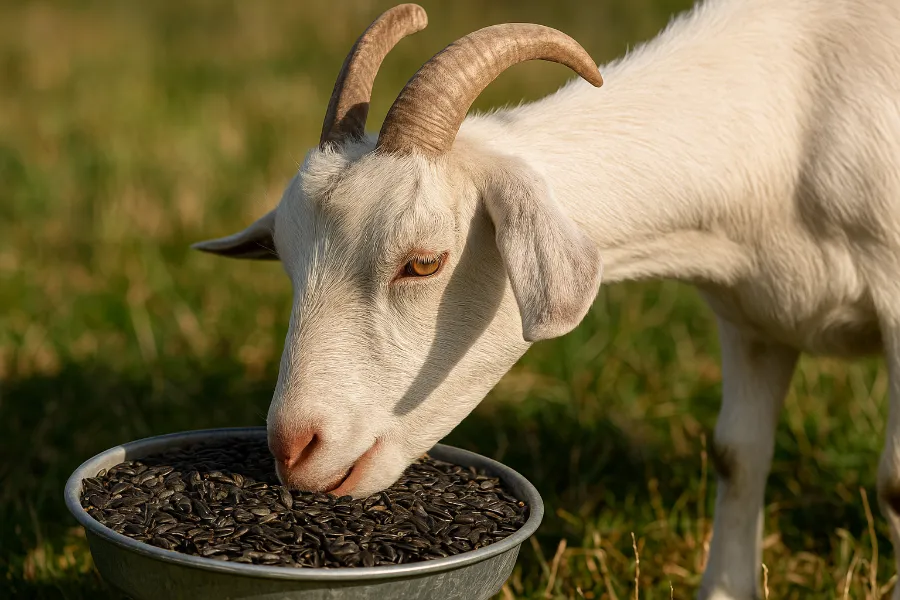
Goat Vitamins: The Small Details That Matter
Big feeds build milk — but goat vitamins fine-tune performance. I learned the hard way that skipping vitamins and minerals eventually costs you in fertility, growth, and milk quality.
I always keep these in rotation:
- Vitamin A for fertility and growth
- Vitamin D for calcium absorption
- Vitamin E for muscle and udder health
- B-complex for stress, metabolism, and appetite
I never rely on blocks — goats simply don’t lick enough from them. Instead, I offer a loose mineral mix made specifically for goats, along with free-choice baking soda for rumen balance.
Organic Goat Feed: Cleaner, Healthier, and Sustainable
As my herd grew, I moved toward organic goat feed — both for health and sustainability.
Organic feed keeps my goats free from synthetic additives and pesticide residues. It also feels good knowing the milk they produce is as natural as possible.
My organic feed choices include:
- Organic alfalfa hay or pellets
- Non-GMO grains like barley and oats
- Field peas for protein
- Sunflower seeds for fat and minerals
- Homegrown fodder or greens from my garden
It costs a little more, but I’ve noticed fewer health issues, shinier coats, and steadier milk output. To me, that’s worth every penny.
Goat Feeding Guide: My Practical Blueprint
Every farm has its own rhythm, but here’s my simple goat feeding guide that works year after year:
- Test your hay when possible for nutrient balance.
- Make roughage (hay, browse) at least 60% of the diet.
- Build your grain mix with 14–18% protein.
- Supplement with field peas and sunflower seeds.
- Add vitamins and minerals daily.
- Feed twice a day, always after milking.
- Make changes gradually.
- Provide fresh water and clean troughs daily.
It’s a simple system, but it works — whether you have two goats or twenty.
Field Peas: My Secret Protein Weapon
Few feeds have impressed me as much as field peas. They’re an excellent, natural protein source and a great alternative to soy-based feeds.
I include about 10–20% field peas in my grain mix. They’re rich in amino acids, energy, and easily digestible for goats. Plus, they’re often locally available — making them an affordable, sustainable addition to any dairy goat diet.
Sunflower Seeds: Shine from the Inside Out
If you’ve ever wondered how some herds have silky, glossy coats, chances are sunflower seeds are in their feed.
Black oil sunflower seeds (BOSS) are packed with natural oils, vitamin E, and selenium — all crucial for reproductive and immune health. I feed around a quarter cup per goat daily, mixed into grain or loose feed.
It’s a small touch that makes a big difference in coat condition and milk fat levels.
Kelp Meal: Nature’s Mineral Multivitamin
No feeding plan feels complete without kelp meal. This ocean-grown supplement provides iodine, magnesium, iron, and dozens of trace minerals that are often missing in soil-grown feeds.
I mix in a tablespoon per goat per day — or let them self-regulate from a free-choice mineral feeder. It supports metabolism, fertility, and immune strength naturally.
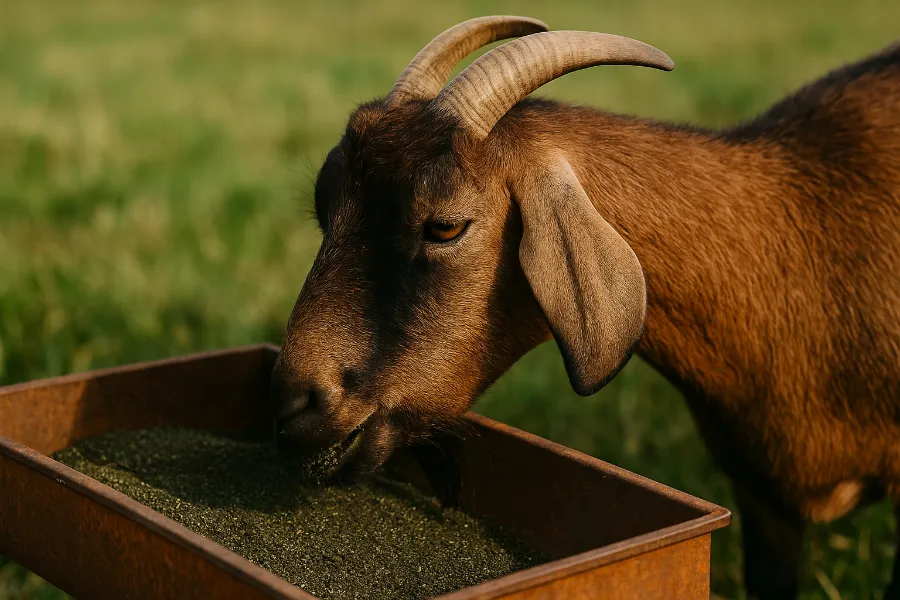
Regenerative Grazing: Feeding the Land and the Goats
In recent years, I’ve fallen in love with regenerative grazing — a system that feeds both goats and soil.
Here’s how I do it:
- Divide pastures into smaller paddocks.
- Move goats every 7–10 days.
- Rest each paddock 30–40 days before reuse.
- Encourage weeds, shrubs, and legumes — goats love variety.
This method builds soil organic matter, improves forage quality, and keeps goats healthier. Less mud, fewer parasites, and better feed — all while giving nature time to heal.
Goat Mineral Deficiency: Spotting and Solving It Early
One of the sneakiest problems I’ve dealt with is goat mineral deficiency. It doesn’t always shout — sometimes it whispers through dull coats, lower milk, or slow recovery after kidding.
Signs of deficiency:
- Dull or patchy coat
- Weak or stillborn kids
- Drop in milk yield
- Poor appetite or fertility
My fixes:
- Offer loose minerals designed for goats.
- Mix in kelp meal for trace elements.
- Provide baking soda for rumen health.
- Watch calcium-to-phosphorus ratios carefully.
Prevention is easier than cure — and once mineral levels stabilize, goats bounce back beautifully.
Final Thoughts on Feeding Dairy Goats
Feeding dairy goats isn’t just about nutrition — it’s about rhythm, care, and respect for the animals and land. Over the years, I’ve learned that the secret to healthy, high-producing goats lies in balance: good hay, proper supplements, clean water, and a calm routine.
Here’s what I remind myself every season:
- Feed quality matters more than quantity.
- Goat hay is the heart of every ration.
- Alfalfa for goats is gold for milkers.
- Never underestimate goat vitamins and minerals.
- Lean toward organic goat feed when possible.
- Follow your goat feeding guide but stay flexible.
- Add field peas and sunflower seeds for natural boosts.
- Include kelp meal for minerals and thyroid health.
- Practice regenerative grazing to feed both goats and soil.
- Watch for goat mineral deficiency — early care saves problems later.
At the end of the day, feeding goats well isn’t complicated — it’s intentional. When your herd thrives, your pastures regenerate, and your milk buckets fill, you know you’ve found your rhythm.
FAQs
The best feed for dairy goats is a balanced mix of alfalfa hay, grass hay, grains, and mineral supplements. Alfalfa provides protein and calcium, while grains add energy for milk production.
Feed your goats twice daily — morning and evening — to maintain steady digestion and milk flow. Always provide fresh hay and clean water throughout the day.
Yes, lactating goats can eat alfalfa daily since it’s rich in protein and calcium. For dry or pregnant goats, mix alfalfa with grass hay to avoid excess calcium.
Dairy goats need vitamins A, D, E, and B-complex for growth, immunity, and milk health. A good mineral mix or kelp meal can supply these nutrients naturally.
Organic goat feed supports cleaner, more natural milk and reduces exposure to chemicals. It’s costlier but often improves goat health and milk consistency.
Provide a loose mineral mix designed for goats and supplement with kelp meal. Watch for dull coats or low milk output — early signs of deficiency.
Regenerative grazing means rotating goats through pastures to rest the land and promote forage regrowth. It improves soil health, reduces parasites, and lowers feed costs.

